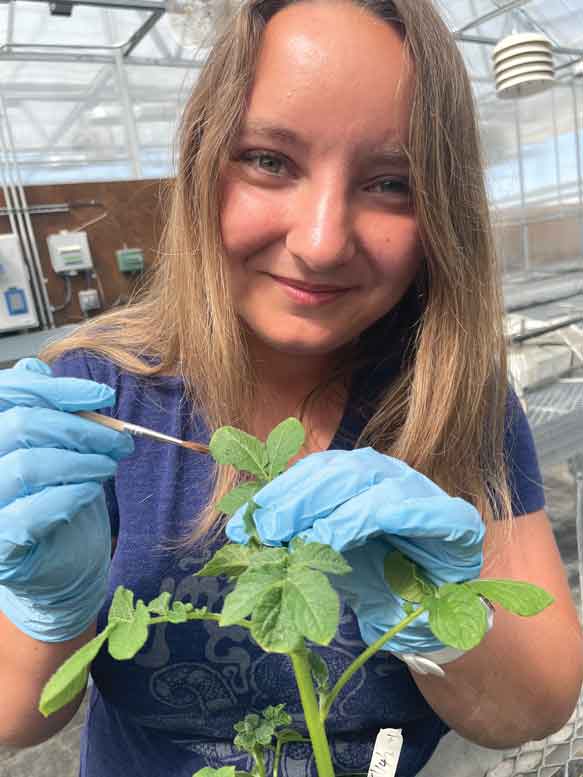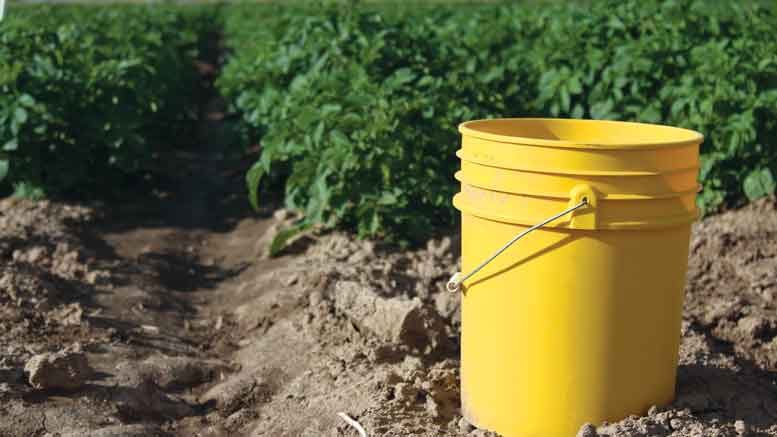|
Click to listen to this article
|
By Kelie Yoho, University of Idaho
Photos by Erik J. Wenninger, University of Idaho
In the United States, there is a prevalent consumer expectation for unrestricted access to high quality produce, and as the most consumed vegetable in the U.S., potatoes are certainly not exempt from this expectancy. A potato’s journey from the field to the plate is difficult and complicated, and it often requires every tool available to farmers to keep their spuds healthy. Sometimes, however, those tools can be quite limited, as is the case with Potato virus Y.
Potato virus Y, or PVY, is the most economically devastating virus affecting potato worldwide, causing severe decreases in yield and tuber quality. Certain strains of the virus cause necrotic rings on the tubers of susceptible potato varieties, making them completely unmarketable.
The disease persists year to year via infected seed tubers, and as such is heavily monitored in seed potato fields during the seed certification process, with very low tolerance for infection. The stakes are high for seed growers, but managing this disease is not an easy task.
PVY is transmitted from plant to plant by aphids, small insects that use their piercing-sucking mouthparts to feed on plants and, in the process, transmit disease. Insect-vectored diseases are often managed by controlling the insect itself since disease cannot spread in the absence of its vector.
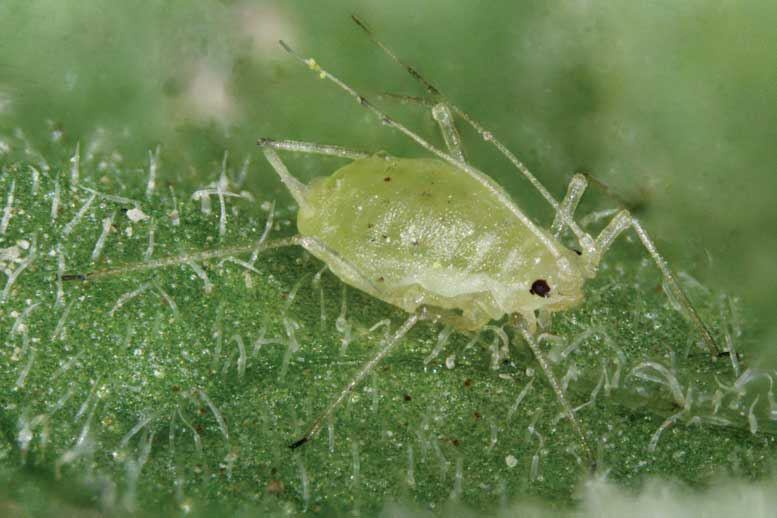
Unfortunately, PVY cannot be successfully managed through insecticides alone. To understand why, we must examine certain aspects of the virus’s biology. To start, PVY is transmitted rapidly by its aphid vectors. An aphid can acquire PVY from an infected plant, move to a healthy plant, and transmit the virus within minutes, sometimes seconds. Insecticides often take 30 minutes or more to act, giving a viruliferous aphid plenty of time to spread infection.
Further complicating the issue is the sheer number of vectors; PVY can be transmitted by more than 60 aphid species, though only a handful of those actually feed on potato. The non-colonizing vector species visit potato fields transiently in search of a host plant. During this search, the aphids exhibit a behavior known as probing, where the insects insert their mouthparts shallowly into the plant to “taste” it. If they don’t like what they taste (i.e., if the plant is not a suitable host), they move on to the next plant. Non-colonizing species are unlikely to settle on a single potato plant, and instead move quickly from plant to plant, spreading disease as they go.
For a grower, this has two important implications: first, most of the in-field spread of PVY is probably accomplished by non-colonizing species, and second, these aphids certainly will not be effectively controlled by insecticides, given the relatively small amount of time they spend in the field. In short, growers need more options for PVY management.
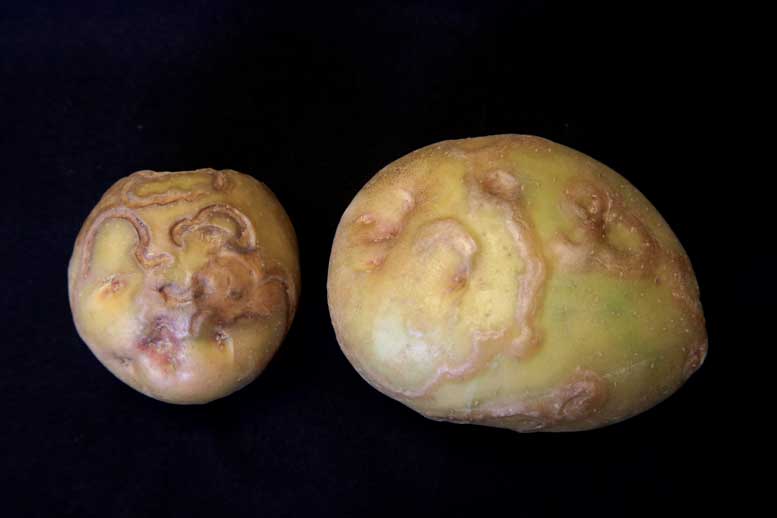
Evaluating Mineral Oil Spray Programs
Luckily, researchers have been addressing this problem for decades. One option with great potential is the use of mineral crop oils, which have been shown to reduce the spread of PVY when used consistently. How this works isn’t entirely clear, though the prevailing theory is that the oil interferes with the virus attaching itself to the aphid’s mouthparts.
Mineral oils haven’t been widely adopted in major potato growing areas in the U.S., however. This could be because the limitations of past studies have caused hesitation on the part of experts to recommend this practice to growers. One major limitation is the use of “rain-fed” conditions in many of these studies, a much gentler alternative to the overhead, center pivot style irrigation practiced by many potato growers. The persistence and efficacy of mineral oils under these different, more aggressive conditions needs to be evaluated before recommendations can be given with confidence.
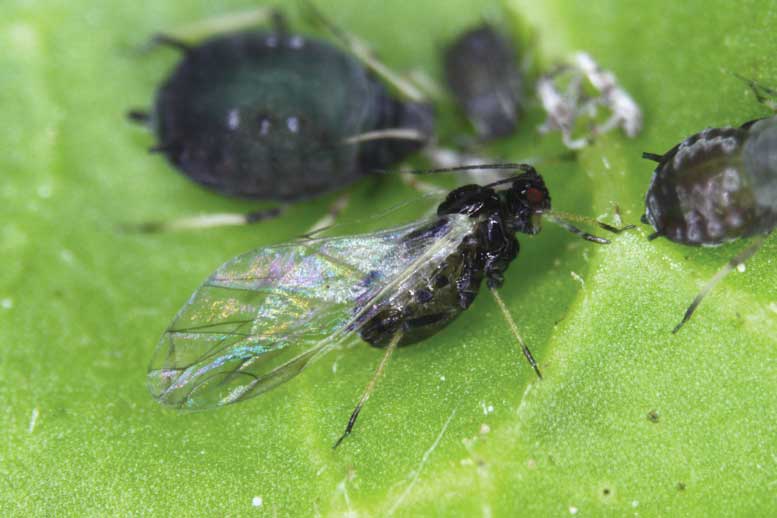
Funded by the Specialty Crop Research Initiative, the Wenninger lab at the University of Idaho is evaluating just that. For several years, we have been growing potatoes under overhead irrigation field conditions and various mineral oil spray programs. Though the research is ongoing and results are preliminary, the trends we have seen thus far are very promising.
Weekly oil applications have consistently reduced PVY infection rates compared to untreated controls, both when applied alone and when used in combination with insecticides, while applying only insecticides may actually increase PVY infection rates compared to no treatment.
This bizarre trend may be explained by the effect the insecticides have on beneficial insects, including predators, parasitoids and pollinators, in the field. Beneficial insects are often much more susceptible to insecticides than the pest insects they help control, and their populations are disproportionately affected by applications. Mineral oils, however, are nontoxic and environmentally friendly, which should limit any effects on beneficial insects. Insecticide-only treatments essentially strip the protection provided by predators without supplementing it.
This is supported by our study, which found that field plots treated with crop oils alone contain beneficial insect communities most similar to untreated controls when species identities and abundances were considered. Plots exposed to insecticides housed less biodiversity and fewer total beneficials. Since these predators can quickly and effectively dispatch an aphid prior to it spreading PVY, it’s certainly worthwhile to promote the health of these communities.
This study is scheduled to be repeated for several more years with additional mineral oil treatment schedules evaluated. In conjunction with other ongoing projects, we hope not only to evaluate whether these mineral oil treatments are efficacious, but also determine appropriate application timings to maximize PVY protection while minimizing costs to the grower.
At this time, we can say that, for growers utilizing overhead irrigation, mineral crop oils do appear to be an effective tool to add to the arsenal against PVY in potato.
